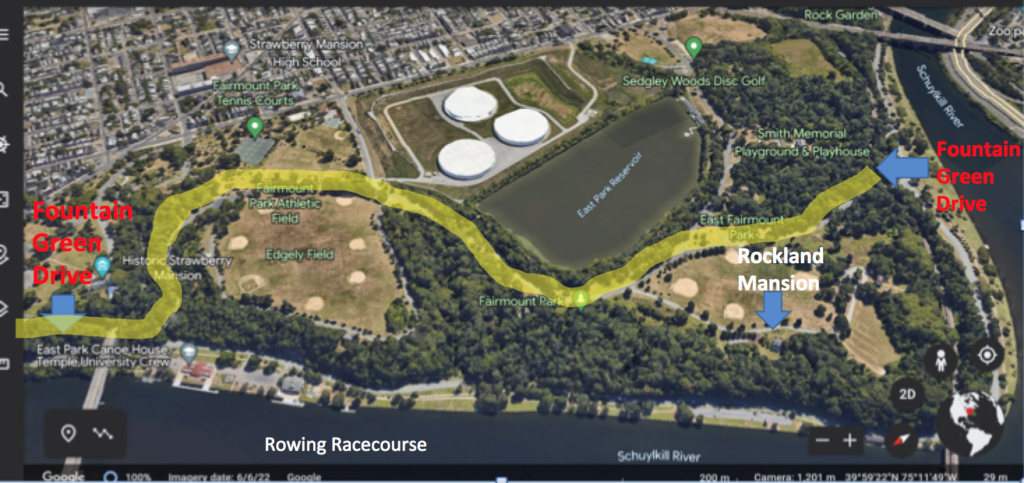With regatta season upon us on the Schuylkill River, motorists on Kelly Drive must detour uphill into East Fairmount Park, where there is also a parking area for spectators. That keeps the drive itself safer for those enjoying the races. In this guest column, Gerry Henwood, a member of a competitive rowing family, tells how he and others came up with the idea in the 1980s along with a dream for a rowing museum.
By Gerard Henwood
In 1985 a group of rowers, their friends, and friends of Fairmount Park came together to transform Philadelphia’s rowing regattas and adjacent riverside recreation space. Our vision was to shut traffic to Kelly Drive (then called East River Drive) and create a better riverside rowing venue.
To do this we had to find a route that would bypass 1.5 miles along Kelly Drive so that the roadway could be used safely by rowers, coaches, and spectators. But with the drive closed, there would need to be a place for regatta spectators to park.
Working with me were rowers Joe Sweeney and Al Lawn, and my sister, Ursula Reed, who was instrumental in raising money to restore the Fairmount Water Works.
As the youngest of seven rowing siblings, I had competed at the Intercollegiate Rowing Association Regatta in Syracuse, NY, and at the Henley Royal Regatta in England. Our vision was to take the spectator experience at the Schuylkill Racecourse closer to the level of those regattas. Both are examples of town celebrations around a regatta theme, with safe, open spaces dedicated to the events.
Stopping through-traffic on Kelly Drive was a critical component for this to begin in Philadelphia. The drive was dangerous on race days.

We called our effort the Schuylkill Expanded Regatta Venue Project. It proved to be a great example of active citizen engagement to better community space. There was no formal planning process, but the City of Philadelphia and the Fairmount Park Commission were all-in to make it happen. The discovery that Fountain Green Drive was a ready bypass around the regatta area, connecting Grant’s Statue and Strawberry Mansion Bridge, really made the idea of closing the river drive and parking in the upper park possible.
The expanded venue began in 1986 at the Dad Vail Regatta. Cars parked on open fields and roads above the racecourse beyond the wooded hillside. Motorists took in stride a detour up the hill which for many brought them through an area of Fairmount Park they had never seen.
The discovery of the bypass route, which went by the historic Fairmount Park house known as Rockland, sparked a companion effort for us.

Why not create a rowing museum housed in Rockland, which sat just above the racecourse finish line?
The group formed the nonprofit American Rowing Historical Society and obtained a lease for Rockland Mansion from the Fairmount Park Commission which needed a new tenant after the Park Police were no longer permitted to be the live-in caretakers. The Federal-style house, built in 1810, had been vandalized and needed substantial repairs.
Along with other volunteers, we spent hundreds of hours working on the house and surrounding landscape. We cleared a path through the woods so people could walk down the hill to the races. We even discovered and unearthed a beautiful stone staircase that linked the riverside to the Columbia Railroad Bridge. A meeting of the National Rowing Foundation at Rockland showed support for the museum idea.
Regatta parking was established adjacent to the mansion as a fundraiser for its restoration. Fundraising from parking for the museum and for support of rowing began.
Rockland as a rowing museum, unfortunately, did not work out as the cost of restoring the mansion was very expensive and the restoration needs of the 19th century houses of Boathouse Row became a high priority at the time. Today it is home to the Psychoanalytic Center of Philadelphia.

The expanded regatta venue continues today as an improvement to what is arguably America’s busiest racecourse and as the conversion of a busy park roadway into a great urban recreation space.
The notion of closing a roadway also inspired the regular summer weekend closure of the West River Drive (now Martin Luther King Drive) on the other side of the river and the growth of accessible green space downriver at Schuylkill Banks.
As for a rowing museum, others have picked up the idea and are trying to find ways to preserve and display the historic artifacts of Philadelphia’s rowing clubs before they disappear or turn to rust and dust.